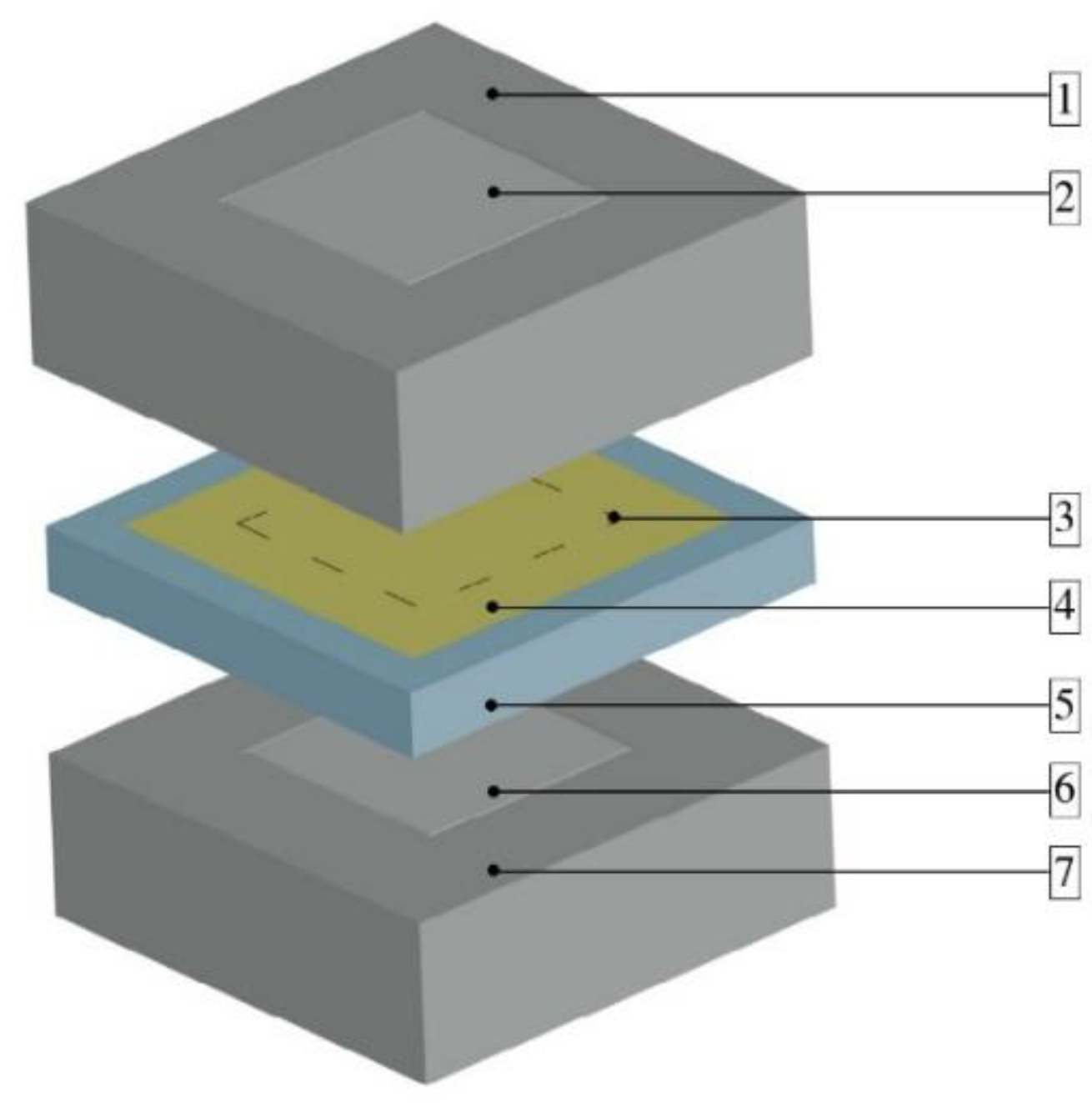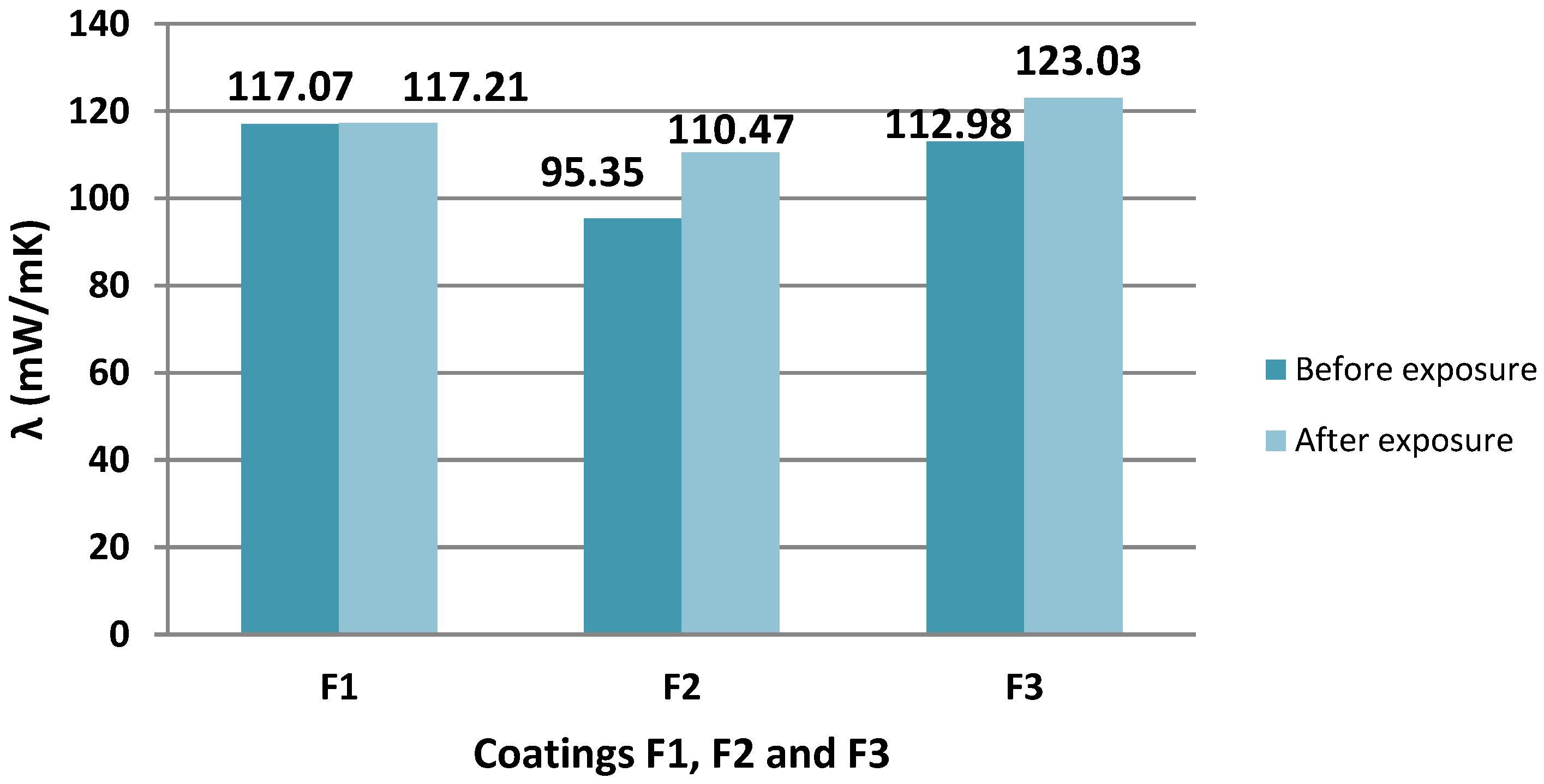Durability of Multifunctional Coatings Made with Additions of Animal Waste and Agro-Industrial By-Products †
Abstract
:1. Introduction
2. Materials and Methods
2.1. Evaluating the Thermal Insulation Capabilities of the Coatings
- Preparing sample substrates from the gypsum board and labeling them for easy identification in subsequent stages;
- Conditioning these gypsum board sample substrates;
- Measuring the thermal resistance and thermal conductivity of each substrate under steady-state conditions using the Lambdameter E500e equipment, in accordance with SR EN 12667:2002 (https://magazin.asro.ro/ro/standard/29334 accessed on 1 October 2023) and SR EN 12664:2002 standards (https://magazin.asro.ro/ro/standard/29333 accessed on 1 October 2023);
- Applying the coatings, which are based on an acrylic binder in aqueous dispersion, enhanced with additives from agricultural waste of both plant and animal origins, among others;
- Allowing time for the coating to mature and ensuring that any necessary chemical reactions take place;
- Conditioning the coated specimens under conditions like those set for the original gypsum board substrates;
- Measuring the thermal resistance and thermal conductivity of each composite sample (i.e., the gypsum board combined with the respective coating) under steady-state conditions, using the Lambdameter E500e equipment;
- Evaluating the thermal properties of the tested coatings, specifically:
- The thermal resistance, determined using the appropriate calculation formula tailored for a steady-state heat transfer regime:where —thermal resistance of the paint layers; —thermal resistance of the gypsum board specimen covered on both sides with the test paint; —thermal resistance of the gypsum board specimen;
- Thermal conductivity of the tested coatings:where —thermal conductivity of the paint; —thickness of the paint layers.
2.2. Assessing the Durability of Coatings under Significant Temperature Fluctuations
3. Results
3.1. Evaluation of the Thermal Insulation Capabilities of Coatings F1, F2, and F3
3.2. Evaluating the Durability of Coatings F1, F2, and F3 under Significant Temperature Fluctuations
3.2.1. Analysis of the Durability for Coatings Applied to a Cement Mortar Base
3.2.2. Analysis of the Durability for Coatings Applied to a Plasterboard Base
- Among the tested coatings, F1 exhibited the most favorable time-dependent evolution of conductivity. Its formulation contained, besides the acrylic binder and adhesive, only the agro-industrial additive or by-product of vegetable origin;
- The most impressive thermal conductivity readings, both initially and at the conclusion of the exposure interval, were attributed to coating F2. Its composition integrated the acrylic binder and adhesive, complemented solely by additives derived from both vegetable and animal sources.
- When considering thermal conductivity, the influence of the perlite additive appears to be less significant compared to the natural additives used.
4. Conclusions
- The three innovative coatings each displayed characteristics consistent with thermal protection materials, despite having thicknesses significantly less than traditional thermal insulation materials.
- The observed evolution of the thermal conductivity coefficient during the test period suggests that the coatings are relatively homogeneous and free of air inclusions.
- The experimental findings suggest that both thermal conductivity and adherence to the substrate can serve as indicators of the durability for such finishes.
- Coatings F1, F2, and F3 are multifunctional. They not only possess the basic attributes typical of finishes—such as a decorative appearance and adhesion to cement mortar surfaces—but they also exhibit resilience under conditions with significant temperature fluctuations (provided there is not the high humidity associated with precipitation) and possess thermal insulation qualities.
- The development of these innovative coatings may represent a new method of integrating and valorizing waste of animal origin and vegetal agro-industrial by-products in construction.
- Innovative coatings, which incorporate lower-quality sheep’s wool and sunflower seed husks, have an aerated structure. This suggests their potential use as finishes with insulating properties. Further research is required to comprehensively understand their properties and their potential as sustainable construction materials.
Author Contributions
Funding
Institutional Review Board Statement
Informed Consent Statement
Data Availability Statement
Acknowledgments
Conflicts of Interest
References
- Yaashikaa, P.R.; Senthil Kumar, P.; Varjani, S. Valorization of agro-industrial wastes for biorefinery process and circular bioeconomy: A critical review. Bioresour. Technol. 2022, 343, 126126. [Google Scholar] [CrossRef] [PubMed]
- Cintura, E.; Nunes, L.; Esteves, B.; Faria, P. Agro-industrial wastes as building insulation materials: A review and challenges for Euro-Mediterranean countries. Ind. Crops Prod. 2021, 171, 113833. [Google Scholar] [CrossRef]
- Bakatovich, A.; Davydenko, N.; Gaspar, F. Thermal insulating plates produced on the basis of vegetable agricultural waste. Energy Build. 2018, 180, 72–82. [Google Scholar] [CrossRef]
- Fuentes, R.A.; Berthe, J.A.; Barbosa, S.E.; Castillo, L.A. Development of biodegradable pots from different agroindustrial wastes and byproducts. Sustain. Mater. Technol. 2021, 30, e00338. [Google Scholar] [CrossRef]
- Binici, H.; Aksogan, O.; Dıncer, A.; Luga, E.; Eken, M.; Isikaltun, O. The possibility of vermiculite, sunflower stalk and wheat stalk using for thermal insulation material production. Therm. Sci. Eng. Prog. 2020, 18, 100567. [Google Scholar] [CrossRef]
- Fiat, D.; Lazăr, M.; Baciu, V.; Hubcă, G. Aspects Concerning the Perlite Recovery in Addition with Polymeric Additives for Constructions Materials. Mater. Plast. 2010, 47, 64–68. [Google Scholar]




| Three-Layer Coating | Thickness, mm | Integrated Materials |
|---|---|---|
| F1 | 4.11 | 40 gB/7 gφ4/4.6 gAD |
| F2 | 4.10 | 40 gB/0.5 gW/4.3 gφ4/2.3 gAD |
| F3 | 4.09 | 40 gB/0.5 gW/1 gφ4/2.3 gAD |
| Triple-Layer Coating | Total Sample Thickness *, mm | Thermal Resistance R, (m2K)/W | Equivalent Conductivity of the Tested Coating, mW/m * K |
|---|---|---|---|
| F1 | 21.12 | 0.1546 | 117.07 |
| F2 | 21.05 | 0.1699 | 95.35 |
| F3 | |||
| 20.96 | 0.1520 | 112.98 |
Disclaimer/Publisher’s Note: The statements, opinions and data contained in all publications are solely those of the individual author(s) and contributor(s) and not of MDPI and/or the editor(s). MDPI and/or the editor(s) disclaim responsibility for any injury to people or property resulting from any ideas, methods, instructions or products referred to in the content. |
© 2023 by the authors. Licensee MDPI, Basel, Switzerland. This article is an open access article distributed under the terms and conditions of the Creative Commons Attribution (CC BY) license (https://creativecommons.org/licenses/by/4.0/).
Share and Cite
Popa, I.; Petcu, C.; Mureșanu, A. Durability of Multifunctional Coatings Made with Additions of Animal Waste and Agro-Industrial By-Products. Chem. Proc. 2023, 13, 22. https://doi.org/10.3390/chemproc2023013022
Popa I, Petcu C, Mureșanu A. Durability of Multifunctional Coatings Made with Additions of Animal Waste and Agro-Industrial By-Products. Chemistry Proceedings. 2023; 13(1):22. https://doi.org/10.3390/chemproc2023013022
Chicago/Turabian StylePopa, Irina, Cristian Petcu, and Alexandrina Mureșanu. 2023. "Durability of Multifunctional Coatings Made with Additions of Animal Waste and Agro-Industrial By-Products" Chemistry Proceedings 13, no. 1: 22. https://doi.org/10.3390/chemproc2023013022







